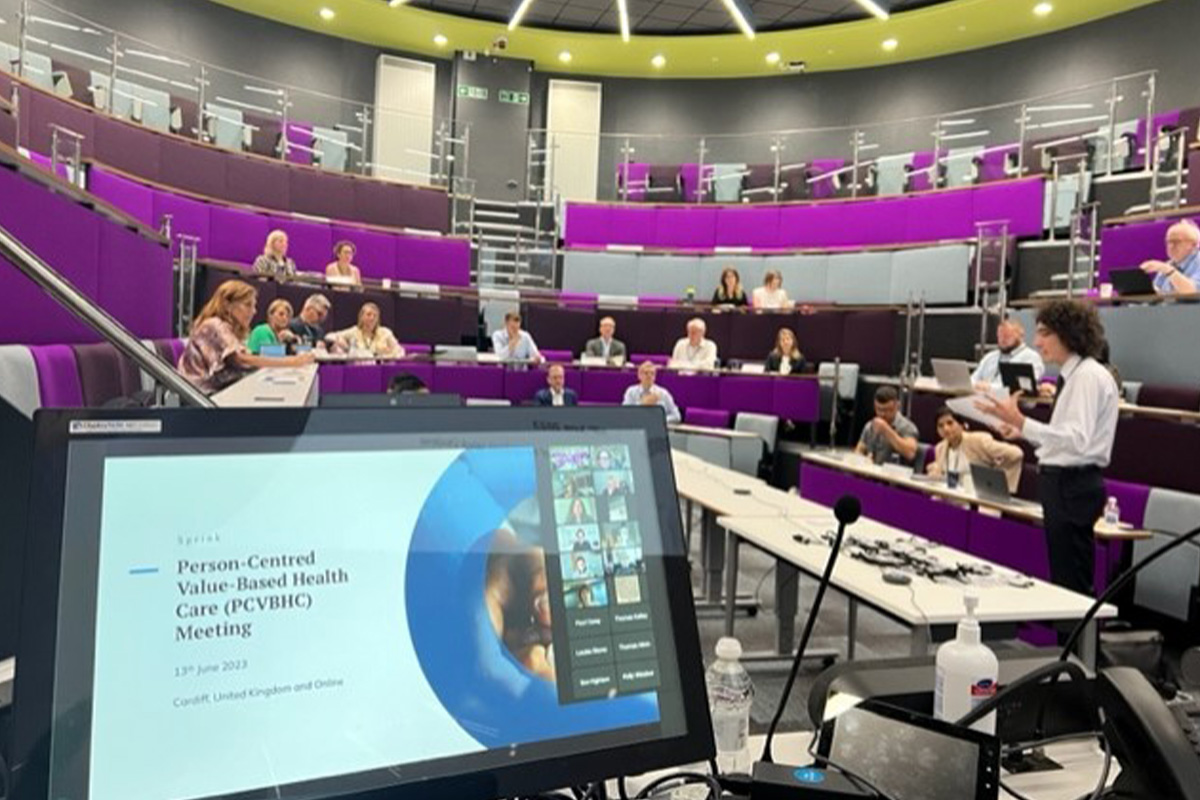By Matthew Salt & Edward Maile.
Food insecurity is a major global health and nutrition challenge[i], and health care organisations have a crucial role in tackling its root causes to improve health and care outcomes in their local areas.
It is defined as a lack of consistent access to enough food for every person in a household to live an active, healthy life[ii]. Those affected may miss meals entirely, consume food of poor nutritional quality, or both. The search for sufficient, healthy food leads to chronic stress and can be a distraction from attending to other important tasks and responsibilitiesi.
Food insecurity is caused by adverse social and economic conditions such as low wages, poor physical access to healthy food, educational disparities, and a lack of affordable housing[iii]. It also traps people in a vicious cycle. The higher cost and lower availability of fresh fruits and vegetables[iv] results in people in lower socioeconomic groups consuming less healthy, balanced food. It is replaced by cheaper, calorie-dense, nutrient-poor food, increasing the risk of developing chronic, food-related conditions such as obesity and type 2 diabetes. Subsequently, these conditions negatively impact people’s health and economic status, due to factors such as the burden of treatment[v] and workplace absence. This further erodes their ability to purchase sufficient, healthy food.
Food insecurity disproportionately affects Black and Minority Ethnic (BAME) groups and people with pre-existing health conditions and vulnerabilities. In the UK, 9% of people are affected by food insecurity[vi], with the Covid-19 pandemic exacerbating the situation. Internationally, food insecurity is likely to worsen due to the rising costs of living in many Western countries[vii]. The impact is starkest in our children, where there are links between educational outcomes and food insecurity due to impaired cognitive development and poor mental and physical health[viii]. This harms life chances and increases the probability of continued food insecurity as the child progresses to adulthood.
While there has been recognition by the United Nations (UN) that eradicating global hunger was a possibility in 1945, and the subsequent inclusion of achieving zero hunger in the UN’s Sustainable Development Goals (SDG)[ix], it is generally accepted that achieving this by 2030 is unlikely[x].
How can health care organisations help?
Guidance has been produced on the opportunities for health care organisations to tackle food insecurity[xi]. This includes screening patients for signs of food insecurity (identification of these groups is achieved primarily through surveys); signposting and educating patients on resources; hosting discrete food distribution programmes for staff and visitors; and providing facilities that encourage healthier food choices.
Given the close link between food insecurity and health outcomes, addressing it should be a priority for mission-driven health care organisations. These organisations are often also anchor institutions, and as such are well-placed to help tackle food insecurity because they have a significant stake in their local area through employment, procurement, training and charitable activities[xii]. The establishment of Integrated Care Systems in England also offers a significant opportunity in this area by joining up health care, social care, local government and third-sector organizations to focus on population health and inequalities[xiii].
There are several promising examples of health care organisations taking action to address food insecurityxi,xiii. Arkansas Children’s Hospital, located in one of the poorest US states with prevalent food insecurity, has established an on-campus garden from which fresh produce is given to a neighbourhood food pantry for distribution to food-insecure people. Furthermore, the hospital canteen serves more than 20,000 free meals to patients yearly. In the United Kingdom, The Royal Orthopaedic Hospital is one of several NHS organisations that has created a food bank to reduce food insecurity for staff and visitors. Morecambe Bay Hospitals provide a direct-to-patient approach in which ward staff assess the likelihood of patients experiencing food insecurity when discharged, and those in need leave the hospital with a care package of food and drink essentials subsidised by partnerships with food suppliers.
At the Global Centre for Healthy Food Environments, we have been carrying out research into the relationship between food and our health care systems. However, it is important to remember that food insecurity is an entrenched social issue that health care organisations cannot solve alone. Addressing the root causes will require collective action across a range of areas, including the economy, welfare, education, public health, urban planning, the environment, and commercial regulation. Specifically, it requires a long-term commitment to implementing evidence-based policies and programs that address the underlying structural factors that perpetuate food insecurity.
Matt Salt is a Senior Project Manager at the Global Centre for Healthy Food Environments.
Edward Maile is Associate Director of the Global Centre for Healthy Food Environments, an NHS GP, and an Honorary Clinical Research Fellow at Imperial College London.
[i] Gundersen C, Ziliak JP. Food insecurity and health outcomes. Health Affairs. 2015;34(11):1830–9.
[ii] What is food insecurity? [Internet]. Feeding America. [cited 17/02/2023]. Available from: https://www.feedingamerica.org/hunger-in-america/food-insecurity
[iii] Drewnowski A. Food insecurity has economic root causes [Internet]. Nature News. Nature Publishing Group; 2022 [cited 17/02/2023]. Available from: https://www.nature.com/articles/s43016-022-00577-w
[iv] The Broken Plate 2020 – Food Foundation [Internet]. The Food Foundation – Broken Plate Report 2022. [cited 17/02/2023]. Available from: https://foodfoundation.org.uk/sites/default/files/2021-10/FF-Broken-Plate-2020-DIGITAL-FULL.pdf
[v] Morris JE, Roderick PJ, Harris S, Yao G, Crowe S, Phillips D, et al. Treatment burden for patients with multimorbidity: Cross-sectional study with exploration of a single-item measure. British Journal of General Practice. 2020;71(706).
[vi] A Crisis Within a Crisis: The Impact of Covid-19 on Household Food Security [Internet]. The Food Foundation. [cited 17/02/2023]. Available from: https://foodfoundation.org.uk/sites/default/files/2021-10/FF_Impact-of-Covid_FINAL.pdf
[vii] DeSilver D. In the U.S. and around the world, inflation is high and getting higher [Internet]. Pew Research Center. Pew Research Center; 2022 [cited 17/02/2023]. Available from: https://www.pewresearch.org/fact-tank/2022/06/15/in-the-u-s-and-around-the-world-inflation-is-high-and-getting-higher/
[viii] Viner R. Food insecurity is toxic for our children and a threat to the future of our Next generation [Internet]. The BMJ. 2021 [cited 17/02/2023]. Available from: https://blogs.bmj.com/bmj/2021/10/18/food-insecurity-is-toxic-for-our-children-and-a-threat-to-the-future-of-the-next-generation/
[ix] The 17 goals – Sustainable development [Internet]. United Nations. United Nations; [cited 17/02/2023]. Available from: https://sdgs.un.org/goals
[x] Cooper M, Kharas H, Müller B. Are we on track to end global hunger? [Internet]. Brookings. Brookings; 2022 [cited 17/02/2023]. Available from: https://www.brookings.edu/blog/future-development/2020/10/22/are-we-on-track-to-end-global-hunger/
[xi] Food insecurity and the role of hospitals [Internet]. American Hospital Association. [cited 17/02/2023]. Available from: http://www.hpoe.org/Reports-HPOE/2017/determinants-health-food-insecurity-role-of-hospitals.pdf?mod=article_inline
[xii] Maguire D. Anchor institutions and how they can affect People’s Health [Internet]. The King’s Fund. 2021 [cited 17/02/2023]. Available from: https://www.kingsfund.org.uk/publications/anchor-institutions-and-peoples-health
[xiii] Lowe R, Mahmood H. Why preventing food insecurity will support the NHS and save lives [Internet]. NHS Confederation. [cited 17/02/2023]. Available from: https://www.nhsconfed.org/long-reads/why-preventing-food-insecurity-will-support-nhs-and-save-lives#c-table-of-contents__list–oneslough-2




